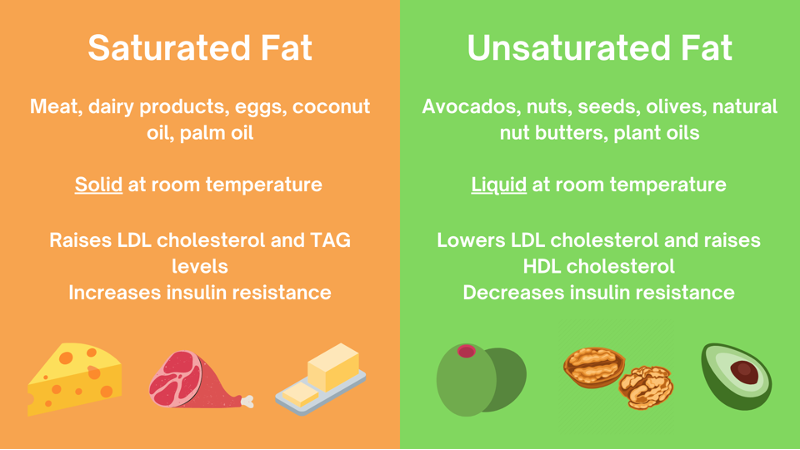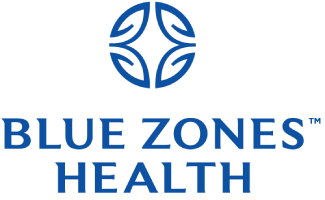Medically reviewed by Dr. Melinda Steele
Dietary fats. These are a few nutrition buzzwords that have gotten a lot of attention and may cause some unease. But not to worry, because we want to focus on diving into what dietary fats really are and discuss why we should focus on healthy sources of fat for our diet. Let’s get started.
What Does a Balanced Diet Look Like?
Before we talk about cutting down on certain types of fat, let’s highlight the importance that healthy sources of fat play in our diet. A balanced diet is composed of three macronutrients: carbohydrates, protein, and fat. That’s right, fat is part of a balanced diet! However, it is not “one size fits all” for exactly how much fat every individual should consume. There are ranges that are recommended. For example, the Institute of Medicine recommends that you should consume between 45-65% of your daily calories from carbohydrates, 10-35% from protein, and 20-35% from fat.1 The important thing to remember is that fat is necessary for a balanced diet, but it is not the main component of the diet. We need to eat dietary fats. But it is not about whether we should eat fat, it is a matter of how much and of what types.
Types of Fat
One way to classify dietary fats is by their degree of saturation. Fatty acids are composed of chains of carbon molecules. When a fatty acid is saturated, this means that there are no double bonds along the carbon chain, and instead, there is a hydrogen atom that occupies each bond. The carbon chain is considered to be fully “saturated” with hydrogen atoms, thus leading to its name. This causes the fatty acid to be very rigid and stiff, which has implications once in the body. Unsaturated fatty acids, on the other hand, do not have a hydrogen atom in between each carbon molecule in the chain. In its place, there will be double bonds, which gives the fatty acid more of a bend to its shape, allowing for it to be more fluid.
Why are these details important? The key component here is that saturated fats are rigid. It is this characteristic that causes a lot of problems. You might have heard the phrase, “you are what you eat.” This is especially true when it comes to the types of fat we consume. Our cells need fat, so when you supply them with saturated fat, that is what they will use. When we eat saturated fat, it becomes incorporated into the cells of our body. The consequence of this is that because saturated fat is rigid, when it becomes part of the cell walls, that causes the cell to also become rigid. This is where it can play a role in various chronic diseases.
Dietary Fats and Heart Disease
First let’s discuss the role that fats play in heart disease. Saturated fats increase our LDL cholesterol. Again, this is because of their rigid nature and consequently causes enzymes that help to clear LDL cholesterol from the blood to not function as well. Check out our video and article on Conquering Cholesterol for more specific information on this topic. Unsaturated fats, or the ones that are less rigid and more fluid are associated with lower blood pressure, which is protective against heart disease.2
Dietary Fats and Type II Diabetes
Fats can also play a role in diabetes. This can often come as a surprise because simple carbohydrates like sugars are what can cause blood sugar to rise. But saturated fat consumption may actually be part of the underlying problem. It all comes back to the rigidity of the fat. Let’s take a look at the image below. Insulin acts like a key to open a door on the cell to let glucose in from the bloodstream. When saturated fat becomes incorporated into the cell wall, because it is rigid in nature, this can cause the key (insulin) to not fit in the keyhole (insulin receptor) as easily. This means that glucose cannot get into the cell and remains in the bloodstream.

https://www.weightlossresources.co.uk/body_weight/insulin-resistance.htm
Sources of Fat
Dietary fat can be found in both plant and animal sources. Animal products are the main source of saturated fats, such as meat, dairy, and eggs along with coconut oil and palm oil. The rest of the plant sources of fat are mostly unsaturated fat such as avocados, nuts seeds, natural nut butters and plant oils. The image below gives a summary of each type of fat. 
Healthy Swaps
Here is a list of some healthy swaps that you can make to decrease the amount of saturated fat you consume.
- Try using a substitute for eggs. If you are making a breakfast dish, try using tofu instead. Check out this recipe for Southwest Tofu Scramble! For baking, you can also use a chia or flax egg for baking. All you need to do is mix 1 tablespoon of seeds with 2.5 tablespoons of water. This makes a mixture that is a similar consistency to a raw egg.
- Try dry sautéing your veggies. All this means is to use water or low-sodium vegetable broth to sauté vegetables instead of added oils or fats.
- Try a black bean burger. This will allow you to still enjoy a burger without the saturated fat that comes in a beef patty. Plus, you get the added benefit of fiber, plant protein, healthy carbs, vitamins, and minerals! Check out this Recipe for black bean burgers.
Dietary fat isn’t something to fear. Instead, it is important to choose healthier sources of fat like unsaturated fat from plants and less saturated fat from animal products. Doing so can have a variety of health benefits. If you would like more information on decreasing consumption of saturated fats and the benefits it can have for you, schedule an appointment with us today!
References:
- Institute of Medicine: Dietary Reference Intakes. Energy, Carbohydrate, Fiber, Fat, Fatty acids, Cholesterol, Protein, and Amino acids. Washington, DC: National Academy Press; 2005.
- Paige E. Miller, Mary Van Elswyk, Dominik D. Alexander, Long-Chain Omega-3 Fatty Acids Eicosapentaenoic Acid and Docosahexaenoic Acid and Blood Pressure: A Meta-Analysis of Randomized Controlled Trials, American Journal of Hypertension, Volume 27, Issue 7, July 2014, Pages 885–896, https://doi.org/10.1093/ajh/hpu024
